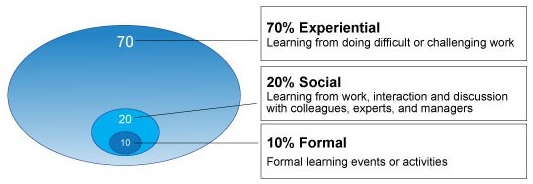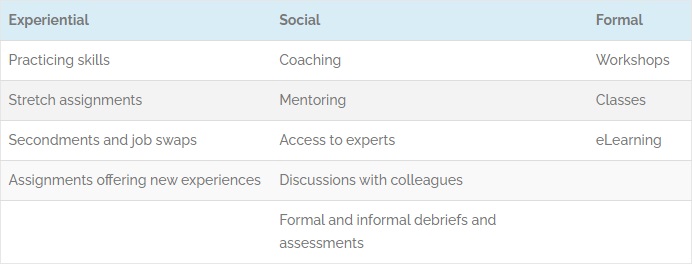The 70:20:10 L&D Model: A Transformative Approach to Learning
Jill W.
Training is not the solution to the majority of performance problems. So why is training so often the first response to performance issues, and if formal training isn't the solution to most problems, what is?
The 70:20:10 learning and development (L&D) model offers a broader approach to learning and professional development. By recognizing that training or formal learning is only one element of development and most learning happens on the job, it expands the scope of learning and development, offering the potential for greater and timelier effect. However, it isn't simple to implement. The 70:20:10 L&D model changes many roles and requires fostering a new mindset across the whole organization.
What Is the 70:20:10 L&D Model?
The 70:20:10 model is based on research showing that successful executives gained their skills and knowledge from the following sources:
- 70% from experience - difficult tasks and challenges at work
- 20% from other people - managers and colleagues
- 10% from formal learning - courses and reading
The 70:20:10 model applies this breakdown to all members of an organization, positing that learning is roughly 70% experiential, 20% social and 10% formal.

Charles Jennings of the 70:20:10 Institute, an expert in the 70:20:10 model, warns against assigning too much significance to these numbers. Exact ratios will vary depending on the industry, organizational culture, worker roles and workers themselves. The point of the model is that most learning is informal; it does not occur in classrooms or through eLearning modules, but as part of the work process.
Adopting the 70:20:10 L&D model means looking at where learning occurs and focusing your efforts on supporting and encouraging learning where it happens instead of trying to fit everything into a formal learning program. If you're wondering what that might mean, consider the following learning opportunities:

Changing the Focus of Learning and Development to Performance Management
With the 70:20:10 model, the new focus of L&D is on performance management. Instead of looking at all performance problems as training problems to be resolved by the acquisition of new knowledge or skills, performance problems should be thoroughly investigated to determine whether they really are training problems or whether motivation or the environment is a bigger factor.
Consider a simple problem. Employees are not booking their time correctly. A traditional L&D department might look at this as a training problem; employees lack either the knowledge of how to book their time correctly or the skills they need to use the application that tracks hours. A training needs analysis will identify the missing knowledge or skills.
A performance management approach considers other issues as well. Perhaps employees know how to use the system correctly, but are not choosing to do so. Perhaps they don't care to learn how to use it properly. How about the system itself? Can it be redesigned to better reflect the way employees work? Should it be simpler, or more intuitive?.
And finally, once the problem is identified, what are the costs and benefits of fixing it? Is it worth the cost of redesigning the system or training employees to use it, or is it less expensive to continue dealing with time tracking inaccuracies?
70:20:10 Benefits
When done well, following the 70:20:10 model means offering effective, timely and cost-effective learning.
1. Makes Learning More Effective
The Ebbinghaus Forgetting Curve states that we forget half of what we learn very quickly if we don't have the opportunity to practice it. Formal training often teaches skills days, weeks or months before they're needed.
70:20:10, on the other hand, relies on pull rather than push learning. Instead of being told to complete a learning event (pushed) before the knowledge or a skill is needed, workers seek out (or pull) resources when they need them. Resources can be anything from written documents to the results of Google searches to expert input to the suggestions of colleagues. This on-demand learning is applied immediately, making it more likely to be remembered.
2. Offers a Faster Response when Learning Needs Are Identified
Charles Jennings has found that one of the advantages of the 70:20:10 model is timeliness. Not only do workers find the learning they need when they need it, but resources can be prepared and deployed much more quickly than full-on learning events.
3. Provides Cost-Effective Learning
Jennings also notes the cost-effectiveness of 70:20:10. Not only does it lower spending on formal learning events - development costs, instructor time, travel costs for instructors and learners, technology - but it also decreases workflow disruption.
Implementing 70:20:10: Changing Culture and Roles
70:20:10 isn't just a Human Resources (HR) or Learning and Development (L&D) initiative. Because it involves transformation of the HR or L&D departments and recognizing that much of the responsibility for personnel development belongs in other roles, it requires a cultural or mindset shift throughout the organization.
Substantial changes must be accepted and applied by people in the following roles:
- Senior management
- People managers
- Learners
- HR or L&D personnel
1. Senior Management - Support and Sponsorship
Like all major changes, successful adoption of 70:20:10 requires effective support and sponsorship from the highest levels of the organization. Senior leaders must work with HR or L&D to develop and align the new strategy.
2. People Managers - The Drivers of Employee Development
Managers play a key role in experiential and social learning. They must recognize that developing their reports is an integral part of their role, not a new task being added to their responsibilities. It is managers who:
- Assign tasks, giving the opportunity to practice new skills and stretch beyond current competencies
- Approve secondments and other opportunities for growth
- Describe expectations and requirements
- Accept that employees will make mistakes and view mistakes as learning opportunities
- Provide timely feedback
- Provide space, time and opportunities for communities of practice and other social networks to develop
- Offer coaching and mentoring
- Help find training - even as the 10%, training remains important
3. Learners - Taking Charge of Their Learning
Learners in a 70:20:10 environment must take charge of their own learning. They must be willing to extend their activities into new, difficult and, at times, uncomfortable areas and take initiative in seeking out the knowledge and skills that will allow them to succeed.
Some employees will be reluctant to become responsible for their own learning. Managers are instrumental in fostering an organizational culture valuing personal growth and development that will help employees understand and accept their role.
4. HR or L&D Personnel - Supporting Learning Where You Find It
Learners are not the only people who may struggle with the changes the 70:20:10 model brings. In most organizations, 80% of the time and budget of the L&D department is spent on traditional, formal learning 70:20:10 means realigning the department's priorities and making a fundamental change to the daily work of its members.
These changes don't mean that learning and development are no longer important; they may look different, but are still important. New HR or L&D roles include:
- Providing support and encouragement for managers and learners
- Helping managers fulfill changing expectations
- Relinquishing attempts to manage learning - in the 70:20:10 model, learning can be facilitated, supported, encouraged but not managed.
- Finding out where learning is already occurring and developing ways to support it
- Changing emphasis from training to performance management
It may be helpful to view the adoption of the 70:20:10 model from a change management perspective. There will be resistance, but there are also great opportunities.
Conclusion
We've looked at what the 70:20:10 L&D model is, its benefits and the types of cultural and role changes it requires. Implementing 70:20:10 demands transformation. Personnel throughout the organization must embrace responsibility for their own development and recognize the tremendous opportunities open to them. Of course, before you think about adopting the model you need to answer one key question: What can 70:20:10 offer you?
📘 Ready to Elevate Your Learning Strategy?
Explore our comprehensive library of eBooks and tools on learning resource development, competency-based learning, and LMS implementation. Transform your training programs with insights from industry experts and practical templates.
Jill W.
Jill is an Instructional Designer at BaseCorp Learning Systems with more than 10 years of experience researching, writing and designing effective learning materials. She is fascinated by the English language and enjoys the challenge of adapting her work for different audiences. After work, Jill continues to leverage her professional experience as she works toward the development of a training program for her cats. So far, success has not been apparent.
